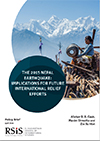22 June 2016
- RSIS
- Publication
- RSIS Publications
- The 2015 Nepal Earthquake: Implications for Future International Relief Efforts
NTRODUCTION
A 7.8 magnitude earthquake struck central Nepal at midday on 25th April 2015 with the epicentre around the Barpak, Gorkha district. Given the relatively shallow hypocentre at the depth of just 8.2km, tremors were felt across the South Asian subcontinent including parts of Tibet and China in the north. The majority of the loss and damages were however concentrated in Nepal. A year on, aftershocks still continue, now numbering more than 450, which are measured more than 4 on the Richter scale. The powerful tremor and resulting aftershocks had significant impacts in over 30 districts of Nepal including the Kathmandu Valley. Official data puts the total loss of lives at 8,969, with 22,321 injured, and 602,592 homes fully destroyed. It is also estimated that the disaster has left over 60,000 people displaced and resulted in economic losses of over US$ 9 billion.
There was an overwhelming international response to the disaster, with many countries and humanitarian agencies rapidly responding to the situation. The response included immediate search and rescue personnel and support, medical teams and support, emergency relief items, as well as goods and services geared for the recovery and rehabilitation phases. Much of the international support also came in the form of assets, from aircrafts to deliver aid, to other equipment and machinery to help in the post disaster relief effort. The emergency disaster response phase officially lasted until 17 May 2015, when the United Nations Disaster Assessment and Coordination (UNDAC) was demobilised. Many of the foreign militaries also finished their missions and returned home around the same time. Humanitarian and relief agencies whose mandates and expertise go beyond the search and rescue and immediate relief phases into the recovery phase, continue to work in Nepal until the time of writing.
This brief aims to provide a general overview of the international response in the immediate aftermath of the disaster, focusing primarily on the search and rescue and immediate relief phase. It also hopes to highlight observations and recommendations, which have emerged from field interviews conducted with both international responders as well as the beneficiaries of the international effort in Nepal. Altogether, this brief will highlight broad trends and field observations from the Nepal experience to inform stakeholders of similar international missions in the future.
Last updated on 22/06/2016
NTRODUCTION
A 7.8 magnitude earthquake struck central Nepal at midday on 25th April 2015 with the epicentre around the Barpak, Gorkha district. Given the relatively shallow hypocentre at the depth of just 8.2km, tremors were felt across the South Asian subcontinent including parts of Tibet and China in the north. The majority of the loss and damages were however concentrated in Nepal. A year on, aftershocks still continue, now numbering more than 450, which are measured more than 4 on the Richter scale. The powerful tremor and resulting aftershocks had significant impacts in over 30 districts of Nepal including the Kathmandu Valley. Official data puts the total loss of lives at 8,969, with 22,321 injured, and 602,592 homes fully destroyed. It is also estimated that the disaster has left over 60,000 people displaced and resulted in economic losses of over US$ 9 billion.
There was an overwhelming international response to the disaster, with many countries and humanitarian agencies rapidly responding to the situation. The response included immediate search and rescue personnel and support, medical teams and support, emergency relief items, as well as goods and services geared for the recovery and rehabilitation phases. Much of the international support also came in the form of assets, from aircrafts to deliver aid, to other equipment and machinery to help in the post disaster relief effort. The emergency disaster response phase officially lasted until 17 May 2015, when the United Nations Disaster Assessment and Coordination (UNDAC) was demobilised. Many of the foreign militaries also finished their missions and returned home around the same time. Humanitarian and relief agencies whose mandates and expertise go beyond the search and rescue and immediate relief phases into the recovery phase, continue to work in Nepal until the time of writing.
This brief aims to provide a general overview of the international response in the immediate aftermath of the disaster, focusing primarily on the search and rescue and immediate relief phase. It also hopes to highlight observations and recommendations, which have emerged from field interviews conducted with both international responders as well as the beneficiaries of the international effort in Nepal. Altogether, this brief will highlight broad trends and field observations from the Nepal experience to inform stakeholders of similar international missions in the future.
Last updated on 22/06/2016





